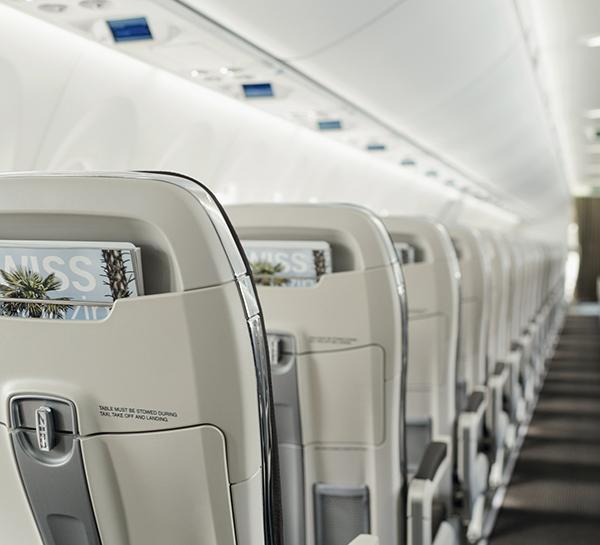Crossover Jet Operators Opt For Variety In Cabin Connectivity And Entertainment

As ever more airline markets are seeing increasing use of crossover narrowbody jets, the airlines operating such aircraft from the Embraer E-Jets E2 and Airbus A220 families have been working to ensure their passengers are entertained and remain connected during their flights.
Inflight entertainment, of course, comes in many forms, with some airlines opting for fully embedded systems, while others – usually, but not always, with shorter sectors – selecting handheld devices for which content is streamed from a central onboard unit. Some carriers are choosing to have the box from which content is delivered, but simply allowing passengers to log in with their own devices – smartphones, tablets or laptops.
Leading the way among the airlines opting for embedded IFE systems on crossover jets is JetBlue Airways, which has continued the strategy it used on its first generation Embraer 190s by offering free movies and DIRECTV on its incoming A220-300s (the carrier is in the early stages of receiving its 100 aircraft order). The Thales AVANT IFE system is delivering these features, while ViaSat-2 provides JetBlue’s Fly-Fi branded connectivity. Passengers also have USB-C, USB-A and AC power sources to charge their devices.
One of the USA’s newest airlines, Breeze Airways – which like JetBlue was founded by David Neeleman – has set itself up currently as an all crossover jet operator. The core of the fleet will be the 80 A220-300s, but during its start-up phase it has also been flying Embraer E1 aircraft in the form of E190s and E195s.
The IFE strategy adopted by Breeze is that of providing the content while passengers use their own devices. The carrier announced in March 2022 a deal with Viasat for the latter to provide inflight connectivity for all the A220s. “While Breeze will operate the Airbus A220 starting in May, the first aircraft featuring Viasat connectivity is expected to enter service in October 2022,” the supplier explains.
The E-Jet fleet already has a streaming service using Anuvu’s Wireless IFE (W-IFE). The turnkey system was put in place in time for launch of the airline’s flights last year and includes all hardware, the Airtime passenger portal and content service provision.
The Viasat system will offer these capabilities but will also include the provider’s fast, streaming internet, which Breeze says is comparable to what users get on the ground. “The key to providing content-rich inflight internet experiences to Breeze guests and crew is the satellite bandwidth offered by Viasat's network,” the supplier notes.
Another Neeleman-founded airlines, Brazil’s Azul, offers free Live TV at every seat on the vast majority of its first generation Embraer 195 and will be offering the same along with Viasat Ka-band inflight connectivity on the 75 E195-E2s it has ordered of which nine have been delivered.
Still in the Americas, Air Canada’s A220-300s (it ordered 45 and has received 27) feature a Panasonic eX1 IFE system at every seat with content available in 15 languages. The content includes more than 1,000 hours of entertainment. The A220s also have satellite based high-speed connectivity for Wi-Fi access and power outlets for every passenger.
Similarly, Delta Air Lines’ A220-100s and A220-300s offer seatback IFE systems as access to Gogo Wi-Fi on nearly all flights.
In Europe, the stage lengths being flown with crossover narrowbody jets tends to be shorter than those in the Americas. This arguably results in a different approach to IFE.
KLM, for example, with the largest E-Jet fleet (E1s and E2s) in Europe, offers Wi-Fi and device charging but no inflight entertainment on its crossover jets. British Airways’ fleet of E190s operating from London City Airport offer neither IFE nor Wi-Fi.
Global launch customer for the A220-100, Swiss does have small embedded screens on all its A220s (it operates the A22-300 too). “These screens, the size of iPhones, are installed in the PSU (passenger service unit) panels above the seats. They show the safety briefing for our guests, the moving map, commercials and silent movies (for example, candid camera, cartoons, documentaries of nature and so on),” says an airline spokesperson, who goes on to explain the key factors behind the airline’s choice. “On the one hand, they provide information and entertainment for our customers, on the other hand a facilitation of the tasks of our flight attendants.”
As for broadband connectivity, Swiss does not yet offer this. “At the time we developed our cabin and received the aircraft, there was no certified technical solution for connectivity on the A220,” explains the spokesperson. “Swiss is looking into options for installing connectivity, but nothing has been decided yet.”
airBaltic has a similar set-up using small screens, but does also offer the airBaltic SKY Service onboard network through which passengers can order inflight meals or do some shopping on their mobile devices.
Big screen, small screen, handheld – crossover narrowbody jet users believe their aircraft can adopt the same sort of versatility in their IFE and connectivity offerings as the aircraft can offer in the routes they serve.





